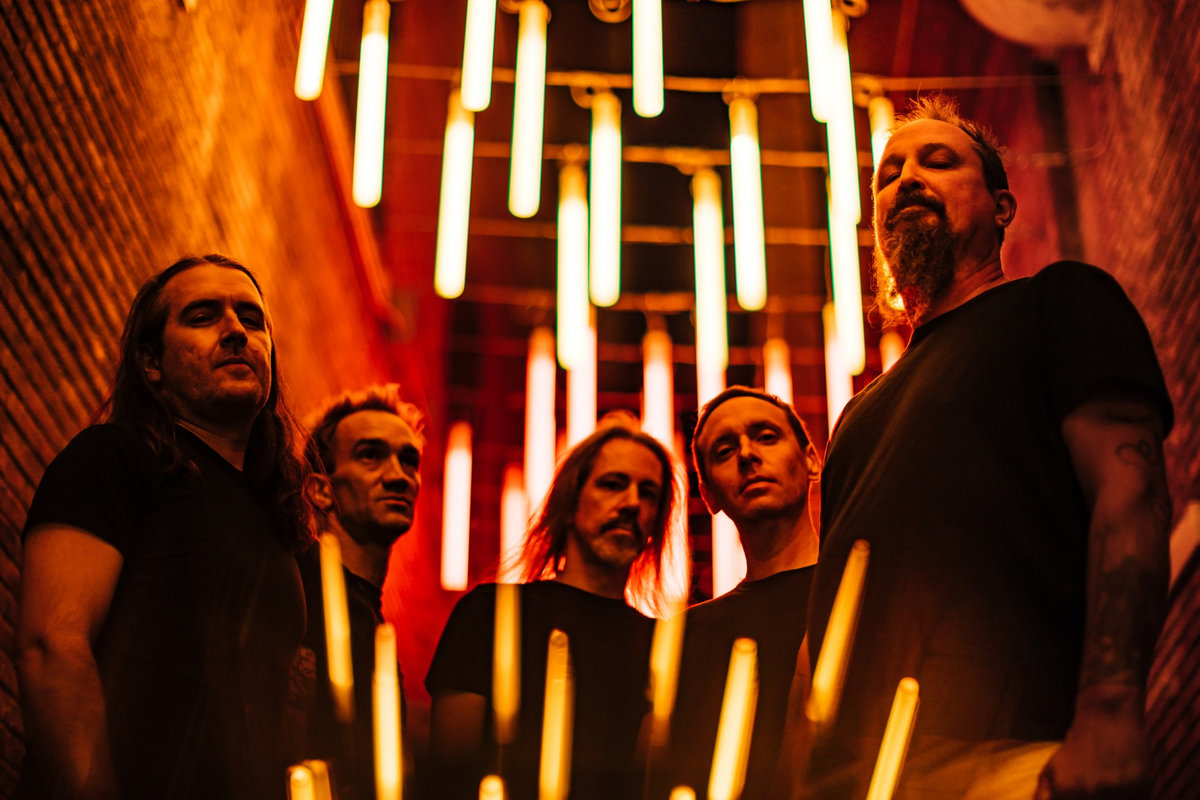The 10-year metal forecast. Plus: The best metal releases of the month!
Welcome back. With the world in great shape and no potentially life-changing national decisions looming on the horizon, I thought we could use this stress-free stretch of placidity to answer an essential question I've had boiling on the back burner since the last time I saw you: Will 2024 be the best year for metal this decade?
Now, to be clear, I'm not asking if 2024 will be metal's best year ever. According to RateYourMusic (RYM), the collaboratively edited online music encyclopedia and rating database I'll be using to help shape this Farmer's Almanac-ass pseudo prognostication, the best year for metal was its first: 1970. Ah, metalheads. Given our affinity for demos and debuts, we're the only cohort on Earth who believes the first time is the best.
Anyway, what interests me more is whether each decade in metal's illustrious history has a predictable rise and fall. Where can you find the best releases? At the start of a decade? Middle? End? What's the narrative? Do decades begin strong, capitalizing on the proto efforts of trailblazers, and then peter out? Or do they start slowly, building steam, until the masses finally realize in the year 2027 that The Black Market's coverage decisions are, in fact, ahead of the curve and not just the arbitrary selections of a fickle dumbass who borked his brain with too much brutal death metal? (Please don't fire me.) See, if we can figure out the flow of a decade, we can head into 2024 confidently, knowing exactly what's in store for us musically. We can make a forecast. Heck, thinking selfishly, we could even automate the rest of the decade's columns, something that people already accuse us of doing anyway. I mean, what, you thought all of those atmo black bands Wyatt and Nelson wrote about were real?
Of course, before I'm inundated with oodles of VC money courtesy of brainless tech bros who misunderstand my intentions and want to crown me as their AI art czar, I must note that music doesn't work that way. You can't predict the impact of art. Ask Bethany Cosentino. Heck, you can't predict anything about art, period. Ask Anata how that new album is coming along. In fact, I would argue that the joy of being a music fan is that you typically don't know what will happen. But, as many exes have told me over texts before blocking my number, when has reality ever stopped me from chasing a pie-in-the-sky idea that I already knew would end badly? Exactly. Let's ride.
Here's the deal: I examined over five decades' worth of heavy metal, crunched the numbers, and have an answer to whether 2024 will be the best year for metal in the 2020s. Hilariously, the results won't surprise you. But first, because I'm a chronic over-sharer, I must take a quick spin through some caveats and my methodology. This is the boring stuff. Feel free to go to sleep. I set an alarm with a 10-hour loop of "You Suffer" when it's time to wake up.
General Caveats:
- I am an idiot.
- I am not a statistician.
- When you ask me about Excel, I still think you're talking about the band.
- I am very gullible and can be convinced of anything quite easily.
- Why yes, since you asked nicely, and because I can't think of a reason why a shady charity for stray dogs who were apparently formally famous poets in another life wouldn't need it, here's my social security number.
Methodology:
- To remove some of the subjectivity from this exercise, I will use RateYourMusic's yearly "top albums" charts for metal and its subgenres. Yes, RYM has its flaws, as I've enumerated many times before. Read those older intros for insight into genuine RYM phenomena such as "flocks of weaklings" (that RYM users rate to impress each other), "prog horniness" (that RYM users will favor prog over other genres), and "revisionist impermanence" (that RYM users are generally mad that older artists aren't Black Country, New Road). Before you get angry at me for stereotyping those humble internet denizens who live to rate their record collections, know I am an active registered RYM user who loves the site, so I can write those things. Anyway, be that as it may, I think RYM's database of thousands of ratings will provide a more precise, albeit retroactively applied, snapshot of what happened in each particular year. At the very least, this wisdom-of-the-masses approach is better than me making the lists by hand. To wit, I think Suffocation's Pierced From Within has been the album of the year every year from 1995 to present. See? No one wants me anywhere near those lists.
- I will condense each year's chart to a top 40. Then, I'll formulate an adjusted average rating for each year's top 40 based on each included album's average rating (RYM users rate albums on a five-star scale in half-star increments) and number of ratings. Yeah, it's average ratings all the way down. For the sake of clarity, I'm going to refer to each year's adjusted average rating as the "adjusted top 40" rating. (Example: Black Sabbath's Black Sabbath currently has an average rating of 4.07 based on 33,495 total ratings. It's one of four albums in the RYM metal chart for 1970. Those albums have a combined adjusted average rating, its adjusted top 40 rating, of 4.09 thanks to a weighting equation I'll mention briefly below. It's fine if none of this makes sense. It's admittedly a stupid intro.)
- I will run a weighted adjustment based on each album's popularity. That is to say that the adjusted average rating for Black Sabbath's Paranoid (48,854 total ratings) should count more than the adjusted average rating for Flower Travellin' Band's Anywhere (766 total ratings). These weighted adjustments will factor into each year's adjusted top 40 rating.
- I think it's worth focusing on the top albums in a given year since there may be a significant disparity between the high and low average ratings in any given top 40. So, I will calculate a separate adjusted average rating that only includes the top 25 percent of albums in a top 40. Behold, the "cream line," named after the fact that cream always rises, and definitely not something else. There's no way someone might misinterpret th-hold on, I'm getting a call from HR.
- Finally, I'll track which genres appear most frequently in these yearly top 40 charts because...well, what the hell, right?
- After collecting the data, I'll explore the trends for each decade. Which year is the highest, lowest, etc. I'll construct a forecast out of those trends.
- If you have any other questions about my methodology, I might've answered them in the more exhaustive Q&A. You can find a recording of that session here.
Acknowledgments and disclosures:
- No rating you see from here on out reflects my personal opinions. I wrote a whole intro complaining about this before.
- Yes, a top 40 for each year is an incredibly small sample size and might not accurately reflect what happened in a year. For instance, it felt like we were drowning in nothing but rethrash and caverncore albums in the 2010s. Will that show up in the data? I don't know!
- RateYourMusic has a different classification for what constitutes metal than Encyclopaedia Metallum. That's all I'm going to say about that hornet's nest built on top of a wasp's nest. If you want to toss rocks at it, do so in the comments.
- Did I mention I'm an idiot?
Wow. That was needlessly confusing. Similar to how falling in love is easier than explaining your feelings to someone, I'm going to put that perplexing morass of made-up jargon into practice. Because the 1970s have so few metal albums compared to other decades, let's remove it from our overall results but use that decade as an example of what I'm searching for. That's not to say the '70s were bad or insufficiently metal. As previously stated, 1970 is the best-rated year for metal per RateYourMusic. Still, RateYourMusic's oddly restrictive metal criteria left me with only a handful of albums for each year in the decade, never coming close to the preferred top 40 threshold. To correct for this paucity of steel, a Manowar song title in the making if someone bought them a thesaurus, I added Metallum's surprisingly more expansive list to the results to increase the sample size. And, by pecking through Metallum for applicable albums, I was finally exposed to some neat hard rock curios, such as Cool Feet's 1976 album, Burning Desire, which is like if Uriah Heep had more leads, and Ñu's 1978 heavy prog gem, Cuentos de ayer y de hoy, which I think we can definitively say is the first Ñu metal album. Mentioning these bands has allowed me to hit my talking-about-actual-music quota to help maintain the illusion that I am a music writer.
Anyway, here are the results:
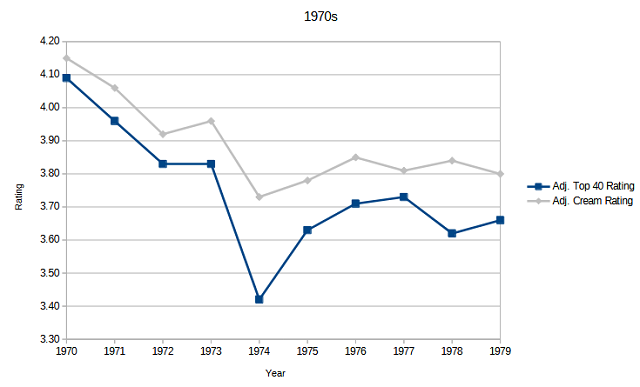
As you can see, the decade starts strongly, falls to its lowest point in 1974, perks back up in 1975, and nearly flattens out for the rest of the span.
Wait. "Falls to its lowest point in 1974?" Uh. I'd like to remind Stereogum that in 2024, the Black Market is a vital resource for finding quality metal even during down years. You could even say the column is even more critical during those times. OK. Crisis averted.
So, what happened in 1974? Well, Black Sabbath didn't release an album. Sabbath's imperial period is some of the best-rated, if not the best-rated, metal on RateYourMusic. In the absence of Ozzy and Iommi, Budgie hops upon the throne with In For The Kill!’s respectable 3.75 rating. Deep Purple's Burn (3.73) and Buffalo's Only Want You for Your Body (3.68), something I'm told every day by strangers whenever I leave the house, are the other albums that cracked the cream line. The rest of the list is filled out by either solid vets or newbies who hadn't yet found their voice according to RYM's userbase. For instance, Rush's self-titled debut, a fine album that prog nerds deride, has an average rating of 3.22. And Judas Priest's Rocka Rolla occupied 1974's basement with a 3.07.
Got it? Cool, let's move on to data that will count. Predictably, the 1980s have a completely different flow than the 1970s. Most importantly, it is the first decade in RateYourMusic that contains complete top 40s for metal, and thus, we will bid Metallum adieu until I undertake my next tortured data project, which will naturally pale in comparison to whatever Metal Stats is cooking up.
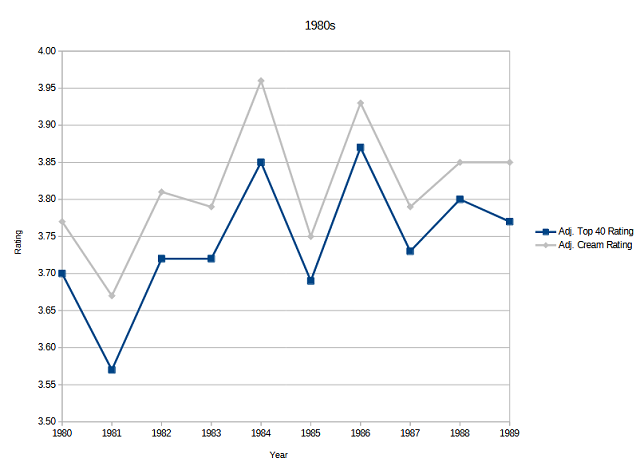
The decade's low point is 1981, a year headlined by Iron Maiden's Killers, Riot's Fire Down Under, Ozzy Osbourne's Diary Of A Madman, and Black Sabbath's Mob Rules. That's like saying the worst year of my life was when I won the lottery.
Unsurprisingly, the '80s spikes twice in 1984 and 1986. If you're still reading this column, you probably know what happened in those years. If not, yes, 1984 was when the absolutely classic album President Ronald Reagan Reads Stories From the Old Testament was released.
What's interesting from my perspective is that, despite the rise of Metallica, whose imperial period is the second-best rated run for metal in RateYourMusic, "heavy metal," the most frequently listed genre in the '70s, still had a stranglehold on these RYM top 40 charts until 1987. From there, thrash is the most frequent genre in these charts until 1991.
Before looking at the 1990s, I want to talk to millennials briefly. When you first started getting into metal, what did scene elders tell you about the '90s? Was it that, because of thrash's implosion and the rise of groove and nu metal, the decade was metal's nadir? If so, the RateYourMusic charts don't bear that out. If anything, the '90s, according to RYM users, were more consistent than the '80s. In fact, the whole decade is surprisingly flat. Worst year: 1993, with an adjusted top 40 rating of 3.75 and a most frequent genre of death metal. Best year: 1995, with an adjusted top 40 rating of 3.81 and a most frequent genre of black metal.
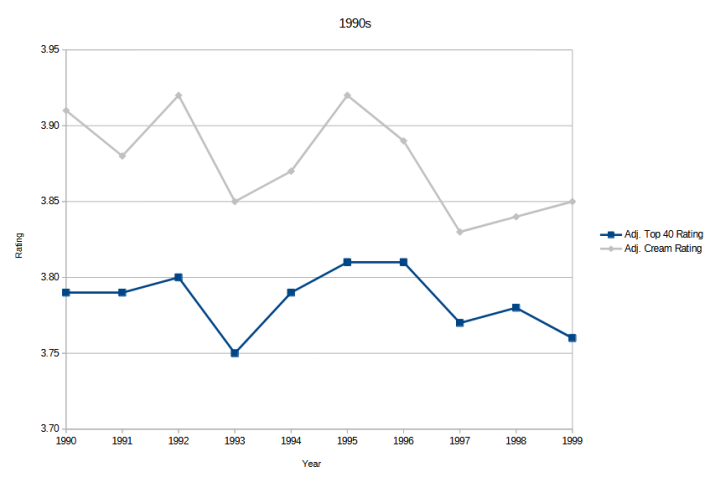
The separation for albums over the cream line wasn't that vast, either. 1995 had an adjusted cream line rating of 3.92. 1997 had an adjusted cream line rating of 3.83 (its most frequent genre was death metal). While this exercise requires us to think of "best" and "worst" years within a decade, I have to point out that, across the extended universe of metal, the '90s seem to be reasonably flux-free, bucking some of the traditional talking points bandied about in old-fart forums. I don't know what's driving that. Nostalgia? Reappraisals? Recognizing that death metal is the superior metal genre? Food for thought.
The 2000s restore the 0.15+ swings we're used to seeing. (It's worth noting that RateYourMusic launched on December 24, 2000, so this is the first decade with then-contemporary ratings. We're always harder on the present than the past and future.) The decade started strong with 2001's adjusted top 40 average peak of 3.86 and then, besides a few bumps, steadily slips to 2008's low of 3.69.
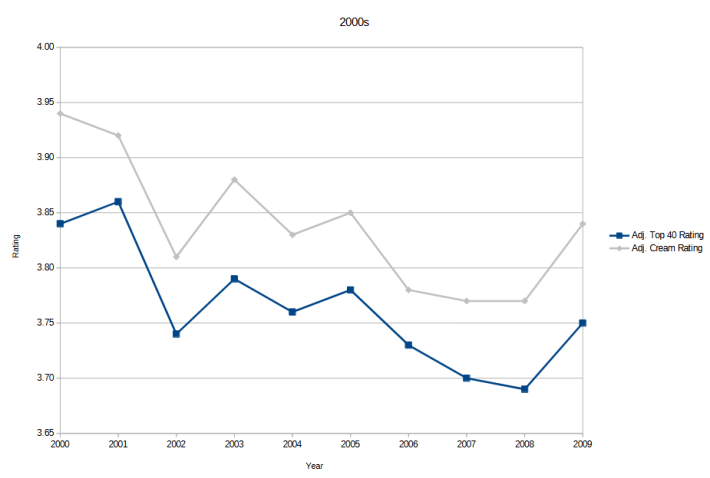
2001 and 2002 also break the streak of death and black metal trading off for the most frequent genre crown, elevating...progressive metal to the top of the heap. Goddamnit, RateYourMusic. NERRRRRRRDS.
The 2010s flatten out like the 1990s, but the adjusted top 40 ratings were much lower. The pit is 2018 with a 3.6, the third-lowest total in metal history after 1974 (3.42) and 1981 (3.57). (The top album was Atka's Untitled Album 1. It's neat that one is finally catching on.)
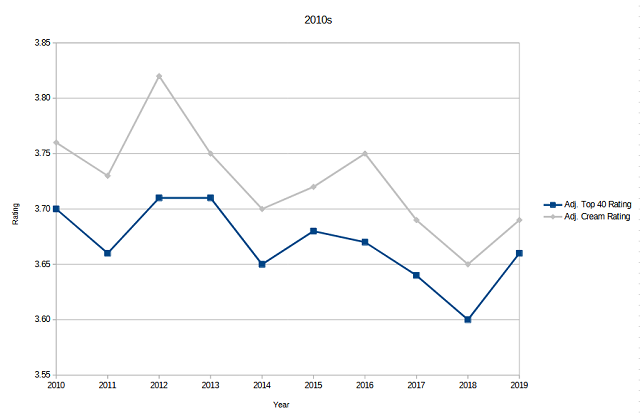
2012 was the high point with a 3.71 and a frequent genre of....progressive metal. Sigh. Anyway, I bring that up to note that black metal has been the most frequent genre champion every year since. It's currently riding an 11-year streak. Since 1980, black metal has been the most frequent genre top dog 19 times, followed by death metal (12), heavy metal (7), thrash (4), and progressive metal (3). No correlation exists between whether a particular most frequent genre makes a year good or bad.
Finally, I think it's too early to notice any trends in the 2020s, but so far, the high point is 2020 (3.66) and the low point is 2021 (3.62). Here's what the adjusted top 40 and adjusted cream ratings look like across metal's history:

OK, let's make some forecasts and run some averages of averages of averages while ranking everything together. I'm not even going to break down how this works. It's so boring. Just trust that this is what the data shows, I say with the same insincere assurance as Nate Silver trying to sell you his obviously inoperable car. Based on the data collected from 1980 to 2019, 2024's adjusted top 40 rating would likely be the fifth-best year of the 2020s. Its cream line material would slot in as the fourth-best. The best adjusted top 40 rating year will be 2026. The worst will be 2027. On the cream side, the best year already happened: 2020. The worst will be, yep, 2027 again. That sound you hear is everyone working feverishly to finish their albums. Looking at you again, Anata.
That said, the reason I'm glossing over those conclusions is that this intro sucks and it's a bunch of hogwash. Here's my definitive answer: What's in store for 2024? No one knows. The only metal band that has a crystal ball is Candlemass. But, hey, here are 10 great songs to check out right now. Please don't fire me. –Ian Chainey
FOUL EMANATIONS FROM THE VOID
10. Malist – “Wind Of Change, Carry Me”
Location: Czech Republic
Subgenre: black metal
Malist’s 2019 debut In The Catacombs Of Time was an incredibly catchy, ice-cold ripper. Loaded with sharp, chainsaw hooks and creaky, croaked vocals, it sounded like the work of the undead, complete with an air of necrotizing decay that seemed to waft from a freshly opened mausoleum. On the strength of tracks like “Uniformity” and “Food for the Flames,” we named it one of our best albums of the year. Since then, Malist have released four more full-lengths, and Ovfrost, the band’s sole engine, has continued to hone his remarkable knack for crafting catchy, big-atmosphere black metal. He’s also venturing further afield, leaving the graveyard and bringing brighter, grander melodies into play. “Wind Of Change, Carry Me” sees Malist embark on extended sun-lit instrumental passages and spoken-word narrated bridges cross into epic territory. But as the netherworld is never far — Ovfrost’s grating, rotting rasp serves as a counterbalance, pulling back toward the darkness below. [From Of Scorched Earth, out now via Avantgarde Music.] –Wyatt Marshall
9. MooM – “La'asot Li Tov”
Location: Tel Aviv Yafo, Israel
Subgenre: powerviolence / grind
MooM nailed the album title. The powerviolence rippers dial in a familiar fury, a byproduct of the tenor of the times on Plague Infested Urban Dump Of The Future, the quartet's debut album after a series of EPs and splits. But the band didn't just nail the album title. It nailed its name, too. "The closest translation to English will be Defect," the crew told Lixiviat Records in a 2017 interview. "For us, it symbolized the disadvantages of being born into this reality while being awake to its greed and corruption."
And yet, for all of its wide-awake rage, such as the scathing "Your War" in which singer Sima Brami screams, "This is your war, it's in my face," Plague Infested Urban Dump Of The Future also has moments that are not only relatable but motivational. "You haven't lost your way yet," the Google Translate version of the lyrics of "La'asot Li Tov" says. The song later asks, "How do I move forward and not go back?" Perhaps it's a nod to the idea that the only way we're going to escape this dump is through rebuilding communities, reconnecting to combat the alienating solitary confinement of depression fostered by authoritarian institutions hellbent on separation and immiseration. "I guess we all wished for this moment to happen in times our region wasn't hit by war and tragedy," the band wrote on Instagram for an album announcement. "But perhaps this timing is a good reminder that some people around here just want to live their lives in peace and find deeper common grounds with each other than shallow concepts such as religion and nationality." After issuing a few fuck-yous, MooM closed its message with "Let's grind." And, goddamn, grind it does.
Like Stress Positions, Eastwood, No Faith, or any of the other core/violence bands I've unapologetically crammed into this metal space, MooM's sped-up sludge riffs, blazing blasts, and searing screams provide an accessible bridge for metalheads. In other words, Plague Infested Urban Dump Of The Future goes hard as hell, taking the Spazz/Slap-a-Ham template and reforming it to fit the band's own voice. Drummer Ariel H. Oliva and bassist Gad Torrefranca lock in to create pounding passages that leave bruises. Idan Ezra's guitar slashes and bares its teeth like a cornered alley cat. Brami yelps and screams, giving one of those cathartic performances that feels like turning the relief valve on your most frustrating day. And, if you find yourself a citizen of the Plague Infested Urban Dump Of The Future, MooM's voice is your voice, too. [From Plague Infested Urban Dump Of The Future, out now via La Agonía De Vivir, To Live A Lie, LIXIVIAT Records, and Taklitim Holim.] –Ian Chainey
8. Cave Sermon – “Beyond Recognition”
Location: Melbourne, Australia
Subgenre: black metal / death metal / post-metal
Cave Sermon don't waste any time on Divine Laughter. After a quick surge of distortion, "Beyond Recognition," the opener to Charlie Park's second album under the Cave Sermon banner, springs to life. Over a barrage of blasts, a half-black, half-death metal riff rages like a five-alarm fire.
Cave Sermon is omnicore in all its scorched-earth glory, the yet-to-be codified strain of modern metal that mixes the active ingredients from many styles into one highly combustible combination. Think Convulsing, Plebeian Grandstand, Michel Anoia, or other bands that seem to find themselves in Total Dissonance Worship's stable of like-minded ulcerated immolators. And what initially set Cave Sermon apart from its omnicore cousins was that it was instrumental. But if you stick with "Beyond Recognition" a few seconds longer, you'll hear the big change that has come to town on Divine Laughter: Like a rolling tremor unleashed by two sliding tectonic plates, a growl takes over the track. Welcome to the fold, Miguel Méndez from MICO.
Now, despite seemingly every Bandcamp comment trying to coax Park into making a new hire, Cave Sermon didn't need vocals. It's a testament to Park's riffing and attention to dynamics that the previous album, Memory Spear, was as engaging as it was without them. But, man, does the human voice ever add an extra dimension to extreme music. Perhaps it's because Méndez has a top-tier throat, but this new Cave Sermon feels so much more vibrant. Of course, Park has evolved as a songsmith, too.
"Beyond Recognition" contains all of Cave Sermon's components: soul-rending black metal riffs, pneumatic press death metal lurches, and Breach-y post-metal trudges. But what's most striking on those first few listens are the avant-garde stretches, such as the Stars Of The Lid-like drone break in the middle of the track that follows a brief noise section that's like a hungry black hole devouring the song. That layered swell, of something bursting forth from nothing, feels like the sun rising. And, at the song's conclusion, those aforementioned black/death/post-metal fusion riffs seem to sparkle because of it, as if fragments of melody are refracting that sunlight. [From Divine Laughter, out 12/8 via the band.] –Ian Chainey
7. Nostril Caverns – “Inhaling The Essence”
Location: Milton, Canada
Subgenre: death metal / grind
With the same spasms of practiced violence as a Takafumi Matsubara project, Nostril Caverns' "Inhaling The Essence" blasts forth with near-inhuman speed and technical ability. It's a blur in the best way, complemented by a fittingly raw and lively production that reminds me of Discordance Axis's Jouhou. But really, "Inhaling The Essence"'s closest comparison is probably this: Imagine if someone fired a shrink ray at one of the spacier death metal bands like Afterbirth, particularly how those cosmosh bands integrate melody into their churns.
There's a lot of tech death in what Nostril Caverns are doing, such as when the drums and guitars interlock like gears. But tech only takes you so far. The key to "Inhaling The Essence" is the feeling it imparts. While it screams by at warp speed, the melody burns away your initial bewilderment at this pell-mell pandemonium, leaving you with the kind of melancholy I'd expect an outfit like Neil Perry to cook up. It's neat. And that helps this track shine when surrounded by its 47 other 40-second-long siblings.
Yeah, Chris Balch, the brain behind Nostril Caverns, loves a challenge, and Implanted Perceptions’s MO seems to be squeezing tech death songs down into 40-second tracks. The thing is, every one of these 48 songs is precisely that: a song. It's a concise songwriting style that reminds me of Wire or, if I really want to reach beyond the confines of loud music, the micro folk of Bob Drake's The Shunned Country. Balch has written memorable material that doesn't need to be legitimized through repetition, so Implanted Perceptions has this bracing quality that doesn't cause listener fatigue despite being a 48-track death/grind album. (I also find it to be oddly calming. I've taken hours-long drives with it on shuffle, its chaos brute-forcing a sense of contradictory serenity. I probably need to talk about that to a therapist.) Still, just the scope of the challenge itself is really something.
"Yeah, I suppose those goals are most interesting to me as a form of personal accomplishment, but they're really only guidelines for the bigger picture," Balch told Invisible Oranges' Jon Rosenthal in 2018. "The ultimate goal of any album is always the same, to make good songs that I'll enjoy listening to regardless of how they were made. I believe a song can be anything, so no matter how you get to the end — whether you add arbitrary songwriting rules or not — it's your job to make an interesting song." Mission accomplished. [From Implanted Perceptions, out now via the band.] –Ian Chainey
6. Ὁπλίτης – “Ἡ τῶν λυσσημάτων ἄγγελος”
Location: China
Subgenre: black metal / thrash / prog
Παραμαινομένη, Ὁπλίτης's fifth overall release and fourth full-length in a little more than a year, marks a shift for the solo black/death/thrash project. While Liu Zhenyang's music in Ὁπλίτης and Vitriolic Sage was always underpinned by a particular progressiveness, Παραμαινομένη free solo climbs toward even more experimental terrain. The Bandcamp tags playfully point at some of the touchstones: "blackened zeuhl," "metal in opposition," and, appropriately for a band so steeped in ancient Greek, "theia mania." Plus, Zhenyang has gone on record with sites like Machine Music, expressing an affinity for underground modern zeuhl acts like Le Grand Sbam. All of that is something on the page. But experiencing the evolution is something else. The concise, slashing, Serpent Column-esque assault of the excellent Ἀντιτιμωρουμένη, Ὁπλίτης's 2023 high-water mark, is still present, but here it's utilized as one part of many that turns these long-form songs into aural adventures.
Even "'Ἡ τῶν λυσσημάτων ἄγγελος," ΠαραμαινομένηὉπλίτης most caustic offering and closest to the Ὁπλίτης that ripped through everyone's Bandcamp collections last year, is a massive leap forward in its experimental inclinations. The song features two of ΠαραμαινομένηὉπλίτης recurring elements: a zeuhl-y saxophone (think Zao or Laktating Yak) and spoken word delivered in what I believe is hexameter (as you can judge by my writing, I am neither a poet nor a linguist). Still, what keeps me coming back to the track is its all-out rhythmic absurdity. There are riffs on this song that sound like Converge's When Forever Comes Crashing sucked into a wormhole that spills out into Florid Ekstasis' where's-the-one universe. And then, check out the precise jackhammer riffs at 1:42 that are like molten Meshuggah chugs poured into the twisted molds of Thantifaxath. Somehow, that's not even "Ἡ τῶν λυσσημάτων ἄγγελος"'s centerpiece. No, that's at 4:58 when Ὁπλίτης erase the song in the same way Rauschenberg did to a de Kooning, leaving a stretch of negative space and brief flashes of boo-scare chords that pop out from the void and would give even Car Bomb heart palpitations. Wild. I'd love to say I can't wait to hear what's next, but I think I'm going to be untangling Παραμαινομένη for a long time. [From Παραμαινομένη, out now via the band.] –Ian Chainey
5. Obsidian Tongue – “The Stone Heart”
Location: Portland, ME
Subgenre: atmospheric black metal
For whatever reason, in the world of new millennium American atmospheric black metal, a decidedly underground thing in and of itself, it still feels like the 15-year-running duo Obsidian Tongue are a bit further underground. Fans of the genre may be familiar with bands like Panopticon, Falls Of Rauros, Obsequiae, and OGs Agalloch, but I don’t think Obsidian Tongue are on the tip of the, uh, tongue for most listeners of all those bands. This is somewhat funny or frustrating because Brendan Hayter (vox, guitars) and Raymond Capizzo (drums) are actually in some of those bands and are connected in some way to all of them. Hayter has played live with Obsequiae and Capizzo drums in Falls Of Rauros and has done live duty with Panopticon, and Obsidian Tongue have toured with Agalloch. But more importantly, Obsidian Tongue rule — their 2013 A Nest Of Ravens In The Throat Of Time is mandatory for any black fan of the genre.
“The Stone Heart,” the title track from a forthcoming EP, is a great introduction to the band. Haunted baritone singing and brooding, dark drips of guitar and accented drums open, build, and give way to a sudden blast of dark energy. Obsidian Tongue have an incredible talent for layering rich, flowing melody into the genre’s obligatory full-on moments, and you’ll ride waves of ethereal magic as the song progresses. It’s orchestral and massive but so well crafted that moments of soaring and crashing drama elide into one work of smeared beauty. It’s remarkable and a must-listen. [From The Stone Heart, out 2/2 via High Roller Records.] –Wyatt Marshall
4. Madder Mortem – “Master Tongue”
Location: Oslo, Norway
Subgenre: prog metal
Old Eyes, New Heart, Madder Mortem's eighth album, is sequenced like a storm surge. Aggressive songs crash upon the shores and then recede, allowing ballads to examine the resulting emotional wreckage. While every album tends to reinvent the core Madder Mortem sound, this ebb and flow is something the Norwegian doom/prog quintet has explored over its last two albums, 2016's Red In Tooth And Claw and 2018's Marrow. Those releases, which contain some of the best music of the long-running outfit's career, capture the same spark that lit up the darkness of Madder Mortem's earlier material. But they were more introspective, allowing the emotions we find ourselves experiencing in our quietest moments to be as weighty as any crushing riff. "Yes, aggression and darkness are still very much present in our music, but we like to explore the whole [spectrum]," drummer Mads Solås told Rock'n'Roll Journalist in a 2016 interview. "And yes, we are older, so the angry stuff maybe takes on a different form now than when we were 20."
"Master Tongue" is one of those angry songs taking on a different form. Musically, the fascinatingly intricate and detailed primal scream sounds like Virus fusing with Mastodon. The oblique, spidery runs in the verses set up the heaving sludge of the chorus and bridges. It's muscular yet delicate, a descriptor that could also be applied to singer Agnete M. Kirkevaag's world-class dynamic and nuanced delivery, that singular voice inspiring every metal writer to beseech you to listen to this band whenever it releases an album. And, like those vocals, you can lose yourself in all the sonic details of the song — guitarists BP M. Kirkevaag and Anders Langberg and bassist Tormod Langøien Moseng must've burned a whole riff notebook on this song alone. However, the sheer force of "Master Tongue"'s impact makes it one of the most immediate on Old Eyes, New Heart. Compare it to "My Name Is Silence," one of the great singles from Madder Mortem's early days, and you can hear how much the band has grown. "For us, I think it's been more of an ongoing transition from starting up relatively inexperienced and learning a lot on the way that has led us to this point," BP explained to No Clean Singing in 2016. "Also, it seems like the albums are always somewhat a reaction to the previous one, although not intentional."
Perhaps "grown" is the wrong word, then. Maybe "matured" is more fitting. Madder Mortem is one of those rare bands that feels like it's matured alongside me, with both of us learning to navigate the complexities of middle age and coming out the other side as different people. It's right there in the title: Old Eyes, New Heart, a fittingly vulnerable and honest assessment of still trying to find hope during times of turmoil. In turn, much of this album feels like these grey years, when the edifices of once-indestructible concepts such as mortality seem to erode more and more every day. As the Bandcamp liner notes point out, Agnete and BP's father Jakob, an artist whose painting adorns the album's cover, passed away last year. And while I'm assuming these songs were composed far before that event, it's hard not to hear them as reactions. Take the closer, "Long Road," a gentle lullaby that's going to be one of the heaviest songs I'll listen to this year. Like life itself, you know it will end. Still, its sudden finality comes out of nowhere. It's a shock even to old eyes that have seen it all. But even when everything stops, the new heart learns how to start again. [From Old Eyes, New Heart, out now via Dark Essence Records.] –Ian Chainey
3. Dismalimerence – “Grief & Its Due I”
Location: Chicago, IL
Subgenre: melodic black metal
We’ve talked about Damián Antón Ojeda’s prolific and amazing output across Sadness, Trhä, and about two dozen of his over bands around here quite often. But as context for those catching up, Ojeda has been on a special kind of tear with his atmospheric black metal band Sadness, known for defining a type of painfully pretty black gaze, and has released about a dozen split EPs with bands that jibe stylistically with Sadness over the past year or so. They’ve been great, and they’ve given Sadness' near-cult following introductions to a number of exciting emerging acts. We’ve written about a couple of them, but the recent split titled Resplendence with the Chicago black metal band Dismalimerence covers a different topography than the rest. The four-piece plays ripping black metal shot through with post-hardcore DNA, merging black metal’s overwhelming riff and blast attack with a stiff upper lip sneer and the occasional slam. “Grief & Its Due I” ranges from ethereal watery ambience to precision blasting and cloud-parting solos in a track that feels like an epic journey but keeps it under six minutes. It’s awesome — also awesome, predictably, are the Sadness tracks that follow, with “Details In Numbercolor” another anthem for summer nights, a reminder to hold onto hope and youth in the face of whatever life throws your way. [From Resplendence, out now via Flowing Downard.] –Wyatt Marshall
2. High Spirits – “In The Moonlight”
Location: Chicago, IL
Subgenre: heavy metal
Chris Black is known for a scholarly mastery of metal, and back when he wrote for OG mag Metal Maniacs, he went by the pen name Professor Black. Professor Black is a name he’s employed at times as a musician, and in his bands Dawnbringer, High Spirits, Superchrist, and others, his songwriting has a sort of old-school aficionado’s quality to it. Across a discography that spans nearly three decades, he’s been honing razor-sharp, riff-forward metal that seems to transmit from some halcyon era of heshers. Guitar licks and other sonic flourishes — a well-placed “Yea!,” a smart melodic run between verses that adds a drop of radical to the warm, understated mix — seem to always land at just the right time, and there’s a vintage quality to it all.
High Spirits (pictured above) has always been a favorite for me, as it takes much of Black’s capital H-M Heavy Metal blueprint and applies it to almost relentlessly positive themes. In a genre that in so many ways is built and centered upon the occult and other fantastical and often dark imagery and ideas, High Spirits slap pictures of downtown Chicago (Black’s home) and airplanes on albums with names like Another Night and Motivator. Love–long distance, star-crossed–is the near constant theme, and Black employs all the epic, timeless melodies and stylistic angles of traditional heavy metal in its service, bringing metal’s over-the-top righteousness and heroism to a theme that seems relatively grounded. But the conviction and pitch-perfect, heart-pounding music will convince you otherwise — life and love can be as epic as any tale from metal’s thematic handbook — and it’s real. “In The Moonlight” is a perfect introduction to the world of High Spirits, where the heart’s desires are the stuff of legend. [From Safe On The Other Side, out now via High Roller Records.] –Wyatt Marshall
1. Obliti Devoravit – “Turned To Poison”
Location: USA
Subgenre: black metal
We skip our December column to run our year-end list, so when January rolls around, we often have a backlog of incredible stuff to run through. This year, nothing was more pressing to get front and center in January than Obliti Devoravit’s latest album, Under My Michigan Sky. The solo black metal project of Tim Lenger, who is a frequent collaborator of Colloquial Sound Recordings head honcho Damian Master in bands like Aksumite and This Station Of Life, Obliti Devoravit sounds like nothing else out there (something that can be said for much of Colloquial Sound Recordings roster). We’ve highlighted OD’s caustic, lo-fi, dreary, and crushing black metal before. Lenger is a bass player first, and he brings a suffocating low-end to much of his work, smothering tracks in a bleak, dread-laden, weighted blanket. A veteran of the Michigan hardcore scene, there’s a punkish snarl and ferocious unpredictability to his work, too.
Under My Michigan Sky is a step into a new, bigger era for Obliti Devoravit. The title track, not featured here, is a stunning and devastating work of draining hypnotic beauty that plants its hooks and gnaws at the soul. Not that cassette-only releases really do this kind of thing, but "Turned To Poison," feels like a single, so we’re going to start there. It’s an absolute ripper that shreds all in its path on the back of dueling harmonized guitars that guide a menacing, anthemic melody. On the mic, Lenger’s possessed, with vocal chords grating and grinding through layers of distortion. It’s all so rich, so massive, and so layered — but raw. When staccato machine-gun riffing takes hold toward the end, and delirious guitar leads intertwine like smoke reaching higher and higher, it leaves you both gutted and in awe. [From Under My Michigan Sky, out now via Colloquial Sound Recordings.] –Wyatt Marshall
HYMNS OF BLASPHEMOUS IRREVERENCE
Doing research for a piece we're working on when I discovered one of the Tool-est forum posts of all time. pic.twitter.com/GkgKnhlZKv
— HolidayKirk (@HolidayKirk) January 23, 2024
We rely on reader subscriptions to deliver articles like the one you're reading. Become a member and help support independent media!
